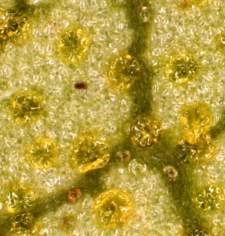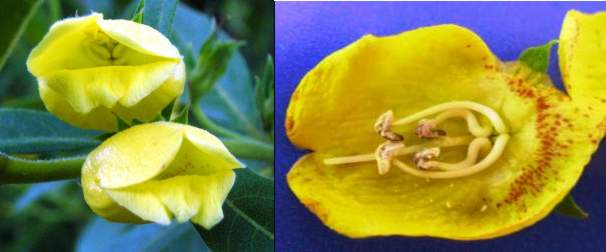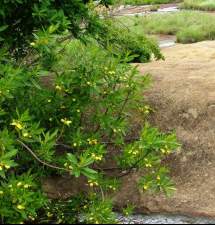Bowkeria citrina
Bowkeria citrina Thode
Family: Stilbaceae
Common names: yellow shell-flower bush (Eng.); geelskulpblombos (Afr.)
Introduction
The wonderful display of the bright yellow flowers, the fragrance of the leaves and the polished brown fruit of Bowkeria citrina, make this beautiful evergreen shrub a prize item in a small garden. This rare endemic is found only in the mountains of northwestern KwaZulu-Natal and Mpumalanga.

Description
Description
Bowkeria citrina is a multi-stemmed shrub about 3 m tall, occasionally tree-like. The stems are greyish white, and most of the plant is dotted with golden glands and covered with fine, soft hairs.

Narrowly elliptical leaves, 70 x 10 mm, have entire or finely scalloped margins (particularly in young plants), and are borne in whorls of three to four. When crushed, they give off a pleasant lemony aroma. The bright yellow scuttle-shaped flowers are borne singly, or occasionally in twos or threes in the leaf axils, from November to June. The inside of the flower shows a pattern of red marks which are probably a guide to the oil hairs for the pollinator.

The fruit is an ovoid, brown, woody capsule, 9 x 5 mm, which splits into two lobes to release minute, ellipsoid seeds. Flowering and fruiting sometimes overlap.
Conservation Status
Status
This species is listed as rare, with a narrow distribution and low abundance, but is not threatened (SANBI 2007).
Distribution and habitat
Distribution description
Bowkeria citrina is found along streambanks and on forest margins in the mountains bordering northwestern KwaZulu-Natal and southern Mpumalanga. It grows well in full sun in gardens with temperate summers and a good rainfall and is frost tolerant but cannot withstand drought. Do not attempt to grow it at the coast as it dies off during the humid summer months.
Derivation of name and historical aspects
History
Bowkeria is a small genus with three species confined to the eastern regions of South Africa. It was named in 1859 in recognition of the contribution of the well-known naturalists, Col. Henry Bowker and his sister Elizabeth, to South African botany. Hans Justus Thode first collected B. citrina in 1920 near Utrecht, where he was working as a tutor on a farm. He gave the specific name citrina because of the lemon yellow flowers (the other two species in the genus are white-flowered). It could equally well have been named for the lemony scent of the crushed leaves, a feature not shared by the other two species.
Ecology
Ecology
Bowkeria citrina is pollinated by the oil-collecting bee Rediviva rufocincta. These bees use specialized setae on their forelegs to collect oil from a broad band of oil-secreting hairs on the inner surface of the pouch of the flower. The oil is then transferred to the hind legs and carried to the nest where it becomes part of the larval food, and possibly part of the nest cell lining.
Uses
Use
There are no records of Bowkeria citrina being used for traditional practices. It does have considerable value as a horticultural subject.

Growing Bowkeria citrina
Grow
Bowkeria. citrina is fairly slow growing, about 400 mm a year and flowering begins in the second year. It is an excellent subject for small gardens as it grows to about 3 x 2 m. In spite of its rarity, the species can be sourced from some nurseries. Good companion plants are low-growing shrubs such as Gnidia triplinervis and Plectranthus zuluensis, as well as water feature plants such as Dietes bicolor, Gunnera perpensa and Zantedeschia aethiopica.
Plant in full sun, and compost and water well in the first few years. It grows best in high rainfall areas and cannot survive drought, so will need supplementary watering in very dry periods. It is frost hardy, and will not do well in hot, humid areas.
This species is particularly attractive when grown near a water feature, but also makes an impact when planted in groups.
Bowkeria citrina can be propagated from seed or cuttings.
Collect fruit in autumn just before maturity and keep in a paper bag to catch the fine seed, which can be stored in the fridge until the following spring. Seed germinates easily, but sow sparingly in a well-drained medium and place in a ventilated position to avoid fungal infection. Seedlings can be transplanted as soon as they are strong enough.
New green shoots or semi-hardwood cuttings about 100 mm long, treated with rooting hormone, usually strike well in a mist bed.
References
- Coates Palgrave, M. 2002. Keith Coates Palgrave Trees of southern Africa, edn 3. Struik, Cape Town.
- Johnson, D., Johnson, S. & Nicholls, G. 2002. Gardening with indigenous shrubs. Struik, Cape Town.
- Killick, D.J.B. 1969. Bowkeria citrina. The Flowering Plants of Africa. 40: t. 1578.
- Nicholls, G. 2005. Growing rare plants. A practical handbook on propagating the threatened plants of southern Africa. Southern African Botanical Diversity Network Report No. 36. SABONET, Pretoria.
- Pooley, E. 1993. The complete field guide to trees of Natal, Zululand and Transkei. Natal Flora Publications Trust, Durban.
- SANBI. 2007. Interim Red Data List. www.sanbi.org.
- Scott-Shaw, C.R. 1999. Rare and threatened plants of KwaZulu-Natal and neighbouring regions. KwaZulu-Natal Conservation Service, Pietermaritzburg.
- Steiner, K.E. & Whitehead, V.B. 1991. Oil flowers and oil bees: further evidence for pollinator adaptation. Evolution 45: 1493-1501.
Credits
Isabel Johnson
KwaZulu-Natal National Botanical Garden
June 2008
Plant Attributes:
Plant Type: Shrub
SA Distribution: KwaZulu-Natal, Mpumalanga
Soil type: Sandy, Clay, Loam
Flowering season: Early Summer, Late Summer, Autumn
PH:
Flower colour: Yellow
Aspect: Full Sun, Morning Sun (Semi Shade), Afternoon Sun (Semi Shade)
Gardening skill: Average
Special Features:
Horticultural zones







Rate this article
Article well written and informative
Rate this plant
Is this an interesting plant?
Login to add your Comment
Back to topNot registered yet? Click here to register.